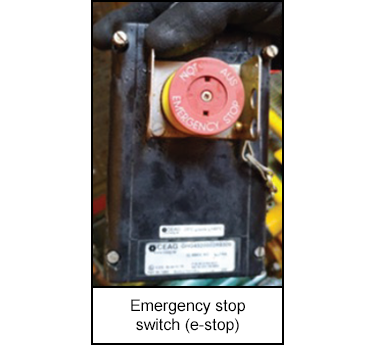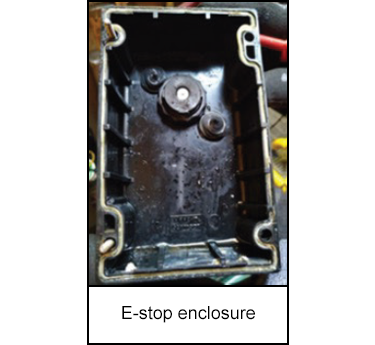-
What happened?
A technician was confirming the position of an emergency stop switch (e-stop) on a lift pump.
When the technician placed their hand on the e-stop, they experienced an electric shock.
The e-stop was inspected and a 188V charge was identified.
The technician was not injured.

-
Why did it happen?
Water had entered the e-stop enclosure, causing the external metal bracket to become electrified.
The design of the e-stop is prone to degradation.
This can lead to water ingress over time.
Current specifications to not prescribe any additional protection for areas with high water exposure.

-
What did they learn?
E-stops have been identified in high water exposure areas that are inconsistent with their ingress protection (IP) rating.
Water ingress into e-stops had not been identified through failure trending and analysis.
Logging information into the maintenance system allows better trending and analysis.
The maintenance system did not correctly identify the e-stops as ‘integrity critical’ and ‘fail to danger’.
The work order to replace the e-stop received a lower priority and work had not been performed in a suitable timeframe.
Update electrical design specifications to prescribe additional protection for e-stops in these locations with high water exposure (e.g. water shedding / shielding to prevent water pooling around IP seals).

-
Ask yourself or your crew
Do you have emergency stop switches (e-stops) in your workplace? Are they subject to high water exposure?
Have e-stops subject to high water exposure been inspected for water ingress? Do they have the correct IP rating?
What steps would you take if a team member receives an electric shock?

Add to homescreen
Content name
Select existing category:
Content name
New collection
Edit collection
What happened?
A technician was confirming the position of an emergency stop switch (e-stop) on a lift pump.
When the technician placed their hand on the e-stop, they experienced an electric shock.
The e-stop was inspected and a 188V charge was identified.
The technician was not injured.

Why did it happen?
Water had entered the e-stop enclosure, causing the external metal bracket to become electrified.
The design of the e-stop is prone to degradation.
This can lead to water ingress over time.
Current specifications to not prescribe any additional protection for areas with high water exposure.

What did they learn?
E-stops have been identified in high water exposure areas that are inconsistent with their ingress protection (IP) rating.
Water ingress into e-stops had not been identified through failure trending and analysis.
Logging information into the maintenance system allows better trending and analysis.
The maintenance system did not correctly identify the e-stops as ‘integrity critical’ and ‘fail to danger’.
The work order to replace the e-stop received a lower priority and work had not been performed in a suitable timeframe.
Update electrical design specifications to prescribe additional protection for e-stops in these locations with high water exposure (e.g. water shedding / shielding to prevent water pooling around IP seals).
Ask yourself or your crew
Do you have emergency stop switches (e-stops) in your workplace? Are they subject to high water exposure?
Have e-stops subject to high water exposure been inspected for water ingress? Do they have the correct IP rating?
What steps would you take if a team member receives an electric shock?
A technician received an electric shock while checking an emergency stop switch on a lift pump, which was found to have a 188V charge. Fortunately, the technician was not injured.
Original material courtesy of Safer Together (Australia)
To access the PDF and PowerPoint versions, please visit https://www.safertogether.com.au/resources/sharing-library/working-with-electrical-equipment-contact-with-live-electricity











